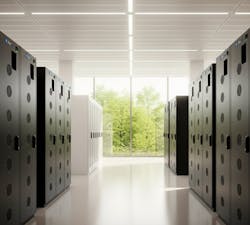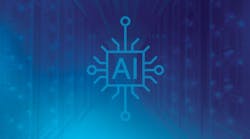Artificial intelligence is rewriting the rules of data center power. The very systems designed to fuel the next wave of innovation are also pushing infrastructure to its breaking point.
The AI Dynamic Power Challenge
Today’s AI systems – from large language models to GPU clusters and high-performance training environments – don’t behave like traditional IT workloads. Instead of drawing steady, predictable power, AI workloads are highly variable. GPU clusters can spike to 15 times their idle power levels in milliseconds, sometimes multiple times per second.
These rapid surges, known as AI Dynamic Power, strain infrastructure in ways legacy systems were never built to handle. Traditional UPS and grid power are designed for smooth curves, not jagged spikes. When these surges hit, their impact ripples from the data center floor all the way back to the grid, creating instability, degrading power quality, and elevating operational risk.
Maintaining stability now requires addressing volatility where it begins – inside the data center. That means intercepting the spikes before they become problems.
Why Batteries Are the First Line of Defense
When utilizing a centralized UPS design, placing high-performance batteries capable of supporting AI dynamic load at the UPS level allows data centers to absorb surges in real time. These batteries can respond in milliseconds, smoothing out sharp pulses and recharging during low-demand periods.
But not all battery chemistries are created equal.
- Lead-acid is reliable but struggles with rapid cycling and short lifespan under AI loads.
- Lithium-ion is energy dense but faces heat buildup, accelerated degradation, and thermal-runaway risk under repeated surges.
- Supercapacitors respond quickly but can’t sustain runtime or scale cost-effectively.
What the AI era demands is a power solution built for responsiveness, reliability, and responsibility – not tradeoffs.
Nickel-Zinc: A Smarter Chemistry for Modern Power
Nickel-zinc (NiZn) technology is purpose-built to meet the demands of modern data centers. With up to three times the power density of legacy chemistries at half the footprint and one-third the weight, NiZn delivers the high-intensity performance required to handle AI surges – in real time.
Its chemistry is inherently safe: nickel-zinc operates across a wide temperature range without the risk of thermal runaway, even during cooling failures. It’s sustainable: with a lower lifecycle carbon footprint, recyclable materials, and a 3x longer lifespan than lead-acid. And it’s resilient: remaining operational even when individual cells weaken, ensuring continuous power delivery without forced shutdowns.
NiZn also minimizes infrastructure risk and cost by eliminating the need for complex fire suppression systems and specialized thermal management—reducing both insurance exposure and operational overhead.
For data centers navigating the convergence of rising energy demands and tightening sustainability goals, NiZn provides power without compromise. And because NiZn technology aligns with emerging ESG reporting frameworks and new regulatory standards such as the EU Battery Regulation and Scope 3 emissions accounting, it helps operators meet both performance and compliance targets.
BC 2 AI: Engineered for the AI Power Profile
Building on its proven BC Series platform, ZincFive developed the BC 2 AI, a breakthrough nickel-zinc battery cabinet designed specifically to address the unique power demands of AI workloads.
BC 2 AI features:
- Advanced BMS, enabling millisecond response to transient surges.
- Dual-use capability for both fast pulse handling and runtime assurance in one compact system.
- A 90Ah NiZn battery supporting thousands of high-intensity cycles with a 10-year warranty.
- A field-upgradable design to evolve with future AI power requirements.
- Seamless integration with megawatt-class UPS systems – backward and forward compatible to minimize disruption.
This modular architecture allows operators to scale capacity as AI workloads evolve, avoiding full system replacement and reducing long-term lifecycle costs. BC 2 AI also integrates smoothly with modern grid-interactive UPS platforms and renewable sources, enabling more flexible and sustainable energy strategies.
A More Sustainable Foundation
Sustainability is no longer a side note in power strategy – it’s a business driver. According to the 2025 Data Center Energy Storage Industry Insights Report, 87% of operators now rank sustainability as a top consideration when selecting power systems and nearly three-quarters (72%) report significant or moderate cost reductions from their organization’s sustainability efforts.
NiZn aligns with this shift:
- 25-50% lower lifecycle emissions compared to lithium-ion or lead-acid
- Highly recyclable materials with global availability
- Fewer replacements, reducing waste and downtime
- No hazardous or flammable components, simplifying operations and compliance
By combining high-performance power with a low-carbon, circular design, NiZn technology allows data centers to meet operational and sustainability goals in parallel – not at the expense of one another.
And as AI power profiles intensify, NiZn’s unique combination of high power density, safety, and sustainability positions it as a future-proof foundation for next-generation data center infrastructure.
Ready for What’s Next
AI isn’t just changing workloads; it’s reshaping the energy architecture of the data center. The transition ahead isn’t incremental – it’s fundamental. Power systems can no longer just sit in the background waiting for outages. They need to actively support daily operations, smooth out unpredictable spikes, and keep infrastructure stable as demand grows.
NiZn technology and BC 2 AI are built for this new reality: fast, scalable, and sustainable by design. As AI becomes the backbone of digital infrastructure, the ability to stabilize power in real time will separate those who keep pace from those who lead.
The future of data center power won’t be defined by compromise – but by chemistry built for what comes next.
About the Author

Tod Higinbotham
Tod Higinbotham is CEO of ZincFive, a manufacturer of nickel-zinc batteries and power solutions. He has a strong track record of successfully growing advanced materials companies in the energy storage, semiconductor, and solar markets. He served as Executive VP/GM for ATMI and led the rapid growth of the company, which was sold for more than $1 billion. Tod was an executive member of the leadership team at Advanced Silicon Materials, a world leader in high-purity silicon materials, the business that was sold to REC to form their solar materials business. He was formerly the CEO of PowerGenix, the company that pioneered the novel nickel-zinc battery technology that has become the core of ZincFive’s solution portfolio.



